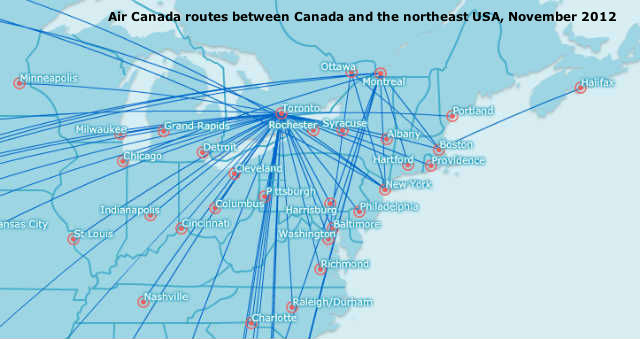Air Canada is seeing some compression to its yield on services to the northeast USA, even as it ramps up flights to the region, say executives at the Montreal-based flag carrier.
Calin Rovinescu, president and chief executive of Air Canada, says the northeast is a "competitive environment" for the airline and that has caused some "damage to yield", during an earnings call today.
The airline reports a 5.4% decline in yield and a 5.2% decrease in unit revenue on its US transborder routes during the third quarter compared to a year earlier. It does not break out specific numbers for the northeast but cites competitive pricing activities on routes to Boston, New York and Washington DC for the fall in yield.
"There's been a lot of capacity that's been added to the market," says Helane Becker, director of equity research and an airline analyst at Dahlman Rose. "The Canadian airlines have been expanding pretty aggressively in these markets."

Innovata Flightmaps Analytics
New York is an especially competitive market for Air Canada. Calgary-based low-cost carrier WestJet has offered eight daily flights between Toronto Pearson and New York LaGuardia since July, adding capacity to an already competitive market.
American Airlines, Porter Airlines and United Airlines also fly between the New York area and Toronto, while Delta Air Lines codeshares with WestJet on the route.
Porter and US Airways have also added flights on key Air Canada routes. Porter began service between Toronto City and Washington Dulles in April, and US Airways between Washington National and both Toronto Pearson and Montreal Trudeau in July.
Shortly after WestJet won an auction for the slot pairs at LaGuardia in late 2011, Air Canada said that it would launch new three daily flights between Toronto and New York's John F. Kennedy and add an additional flight to its Toronto to LaGuardia schedule for hourly service from this past May.
"More capacity is maybe not the best solution," says Cameron Doerksen, a Montreal-based analyst at National Bank. However, he says that Air Canada is anticipating some cost savings from the shift of 15 Embraer 175s to its partner Sky Regional Airlines from its mainline fleet.
The E-175s fly from Air Canada's Toronto Pearson and Montreal Trudeau hubs to destinations in the northeast.
Another potential cost saving measure for the airline is the implementation of its trans-border joint venture with United. A deal that was reached with Canada's Commissioner of Competition in October will allow Air Canada and United to finalise and implement the agreement in the near future, says Rovinescu.
Becker does not expect the extra capacity to last. "Airlines are not altruistic. I think you'll see service pattern adjustments," she says.
Air Canada also saw declines in yield and unit revenue on its flights to Australia, the Caribbean, Mexico and Latin America during the quarter ending 30 September. Yield fell 3.8% and revenue per available seat mile (RASM) by 2.6% on the routes compared to 2011 due to an increase in industry capacity and competitive pricing to South America.
Yield and RASM were up in the airline's other segments with the Pacific region showing the largest increases. Yield was up 13.3% and unit revenue 14.5% versus a year earlier, led by higher fuel surcharges and fare increases.
Air Canada reports that headline passenger revenue per available seat mile (PRASM) increased by 2.2% to 15.9 Canadian cents during the quarter.
System traffic was up 0.8% on a 0.2% increase in capacity. The load factor rose by 0.5 percentage points to 86.3%.
Air Canada reports C$554 million ($556.1 million) in earnings before interest, depreciation, amortisation and rental (EBITDAR), which was up 3.6% year-on-year, during the quarter. Adjusted net income was up 19.2% to C$230 million.
"It's a decent result for Air Canada," says Doerksen on the airline's third quarter results. "They're moving in the right direction."
Source: Air Transport Intelligence news























